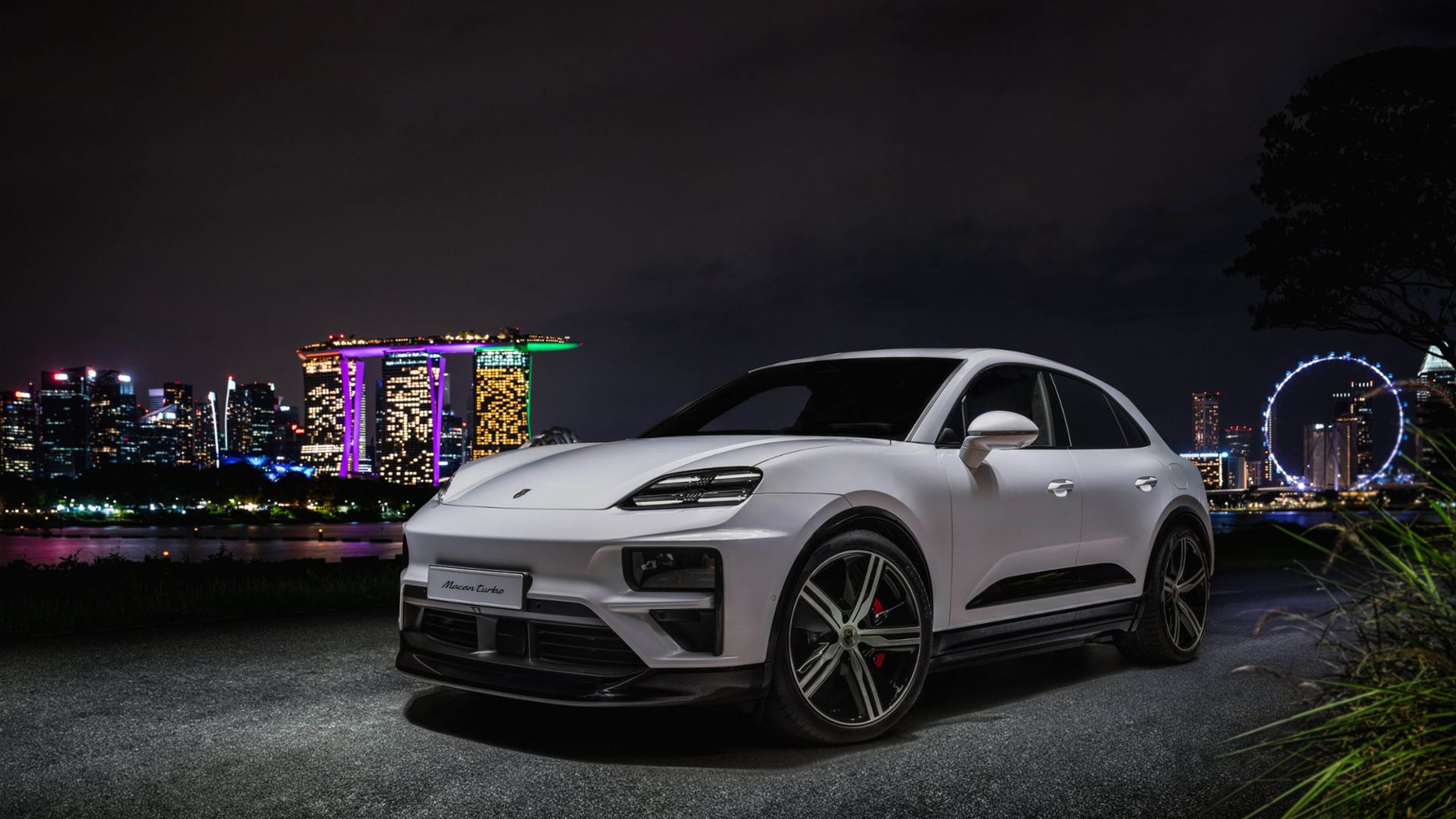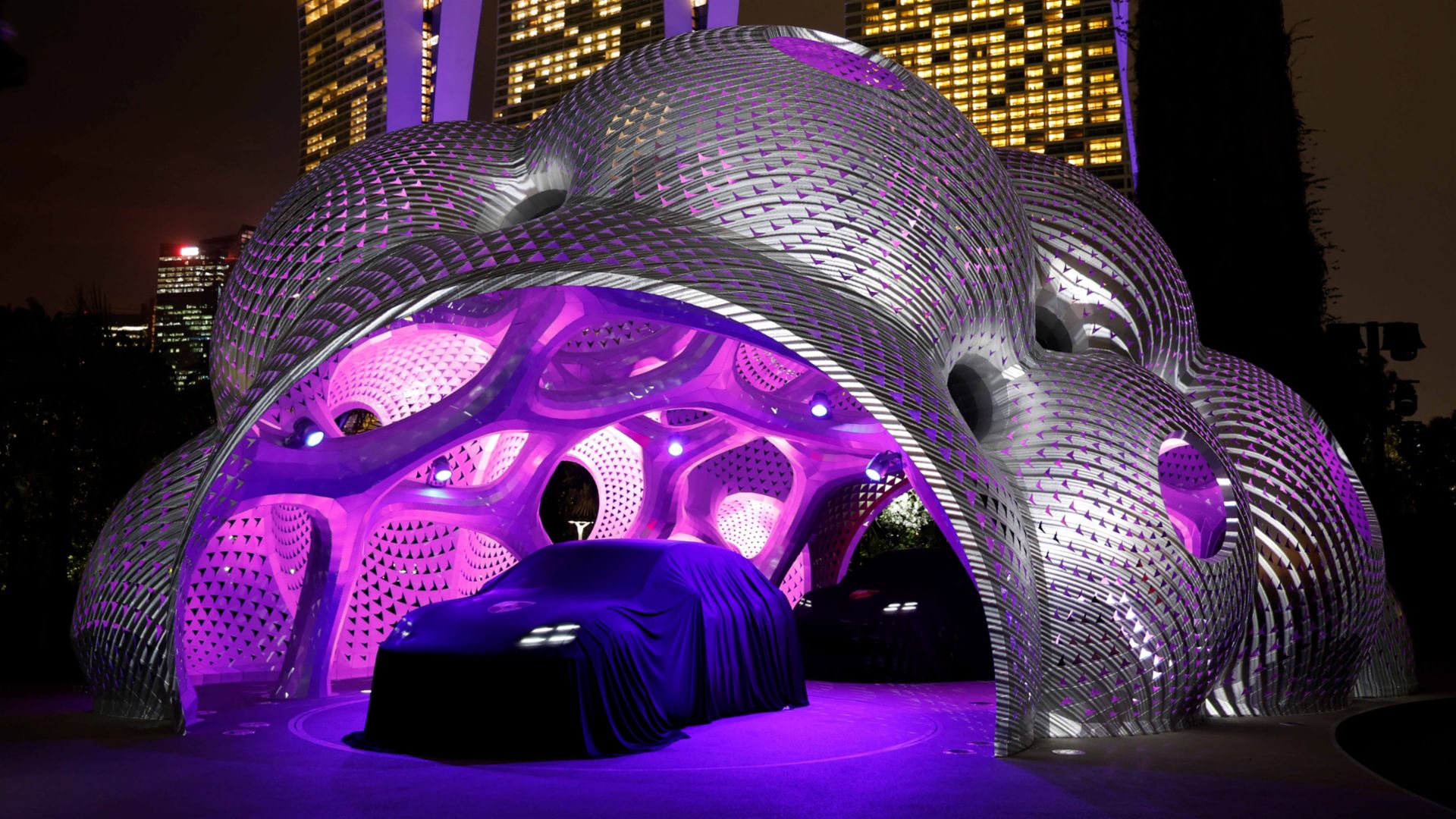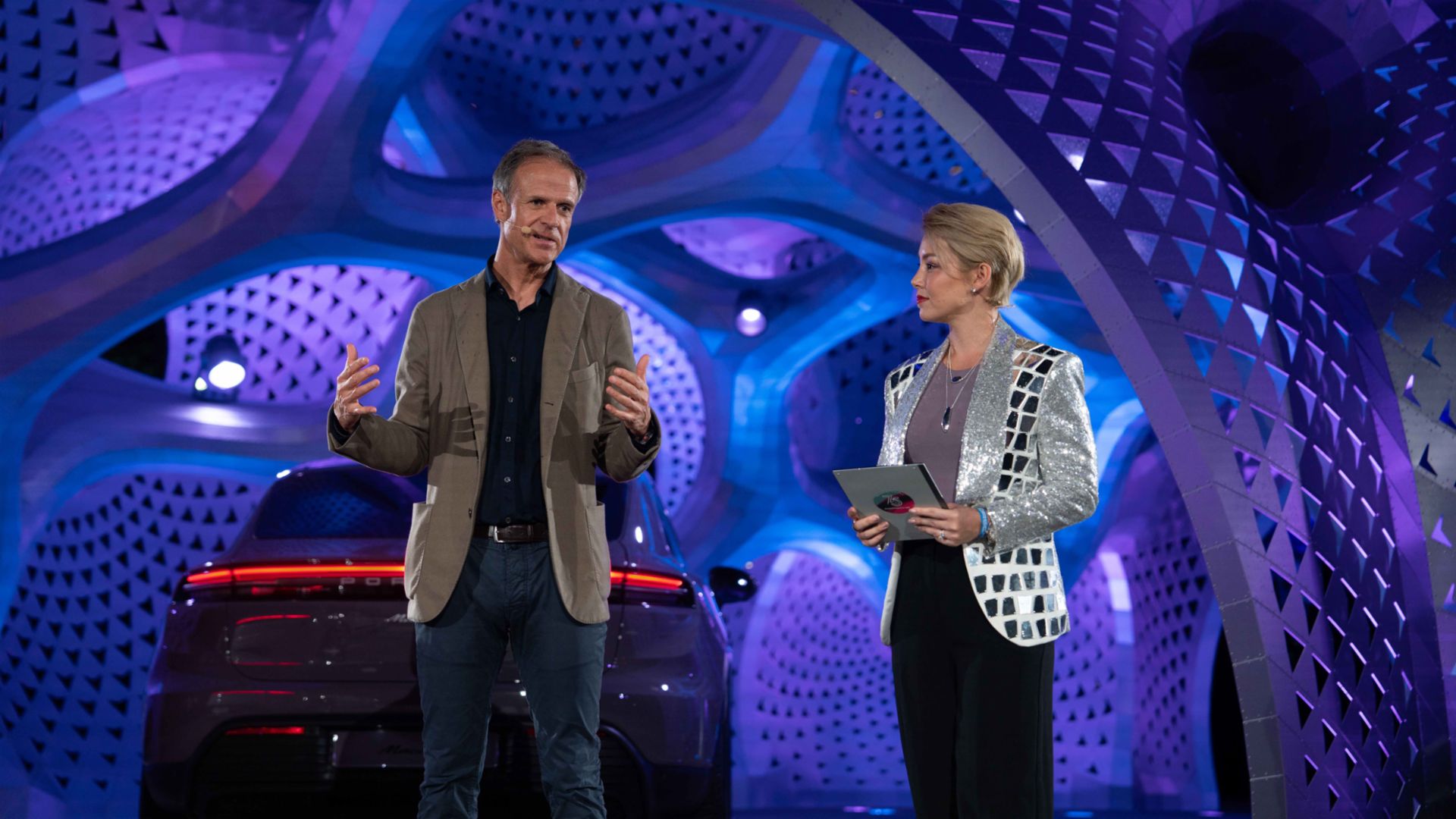On Thursday, 25 January 2024, the new all-electric Macan was unveiled by Porsche in Singapore. The successful SUV, now in its second generation, underwent a significant transformation.
The new Macan, featuring powertrains with capacities of up to 470 kW (639 PS), showcases E-Performance across various terrains and boasts high day-to-day usability. The electric models exhibit an electric power consumption combined (WLTP) ranging from 21.1 to 17.9 kWh/100 km, CO₂ emissions combined (WLTP) at 0 g/km, and an electric range combined (WLTP) spanning 516 to 613 km, with an electric range in town (WLTP) reaching 665 to 784 km.

A decade after its initial launch, the Porsche Macan enters its second model generation, now exclusively in an all-electric form. The Macan 4 and Macan Turbo, with their progressive design, Porsche performance, long-distance range, and practicality, aim to meet the expectations of SUV enthusiasts. Oliver Blume, Chairman of the Executive Board of Porsche AG, expressed, “We are taking the Macan to a completely new level – with exceptional E-Performance, the new Driver Experience, and a very impressive design,” during the world premiere in Singapore.
The electric motors draw power from a 100 kWh lithium-ion battery in the underbody, utilizing the newly developed Premium Platform Electric (PPE) with 800-volt architecture. Fast charging capabilities of up to 270 kW allow for a 21-minute charge from 10 to 80 percent at suitable stations. The Integrated Power Box (IPB) contributes to efficiency, combining the on-board AC charger, high-voltage heater, and DC/DC converter. The Macan achieves a combined WLTP range of up to 613 km (Macan 4) and up to 591 km (Macan Turbo).
The new Macan, characterized by Porsche’s design DNA and optimized aerodynamics, presents a dynamic and dominant appearance. With Porsche Active Aerodynamics (PAA) and a drag coefficient of 0.25, the Macan is among the most streamlined SUVs, positively impacting range and power consumption.
Increased luggage space in the Macan, owing to electrification, reaches up to 540 liters behind the rear seat bench, along with a ‘frunk’ compartment under the bonnet. The driver and front passenger sit up to 28 mm lower, while rear passengers sit up to 15 mm lower with enhanced legroom.

Inside, the cockpit features modern digital interfaces, analog control elements, and a customizable LED light strip. The Macan employs the latest-generation display and operating concept, including a 12.6-inch curved instrument cluster and a 10.9-inch central display. Android Automotive OS powers the infotainment system, and a new Porsche App Centre allows direct access to third-party apps.
Porsche prioritized driving dynamics, steering feel, and a sporty seat position in Macan’s development. Both the Macan 4 and Macan Turbo boast all-wheel drive, controlled by Porsche Traction Management (ePTM) for responsive handling. The Macan also introduces rear-axle steering for a compact turning circle and enhanced driving stability at higher speeds. The optional air suspension includes Porsche Active Suspension Management (PASM), offering electronic damping control, while Porsche Torque Vectoring Plus (PTV Plus) contributes to traction and stability in the Macan Turbo.
Just before the global debut of the electric Macan, Michael Mauer, the Vice President Style Porsche, engaged in discussions about the demanding task of updating the well-established design of the SUV.

Mauer emphasized that the new Macan marked a groundbreaking moment as the first model to undergo electrification within an existing and recognizable product identity. According to the Vice President, each new sports car needed to maintain a distinct connection to the Porsche product family while being perceived as a fresh addition. Ensuring visual consistency was deemed crucial for the Porsche brand, and Mauer acknowledged the challenge of finding the right balance between staying “quintessentially Porsche” and embracing innovation.

Mr Mauer, Porsche is kicking off the year with a real highlight, in the form of the new Macan. In your role, how do you approach the task of designing the first all-electric Macan?
Michael Mauer: Before we think about specific details, the strategic approach plays a crucial part. For example: What distinguishes the model? What did its predecessors look like? This was a particularly exciting challenge with the new Macan. We presented the first generation in 2013 and have consistently, but very mindfully, updated it since then. In broad terms, this has given the Macan a well-established product identity across global markets. With each new generation, our mission is to strike the right balance between familiar design characteristics and new elements. Specifically, we must make each new sports car clearly, recognisably part of the Porsche product family and of its respective model line. Yet it also has to be perceived as ‘the new one’. This visual consistency is extremely important for our brand. The new Macan is also the first model that we are making fully electric, but which already has an existing, established product identity. So this raises the questions: How ‘new’ does the ‘new one’ have to be – what’s too much, what’s just right?
How do you find that balance? What are the parameters that determine whether the model will be well received by customers?
Mauer: That’s difficult to answer in general terms – the design process happens years before the market launch of a car. There are no strictly objective parameters by which we can evaluate the attractiveness of future models. With Porsche design principles, on a brand level we have developed a set of guidelines that help us keep our designs in line with our strategic objectives in the course of our daily work. For Porsche, we have defined three key concepts that describe the character of the brand: Focus, Tension and Purpose. In essence, you could say that these key terms describe what distinguishes a Porsche product – what makes it a ‘quintessentially Porsche’ experience for customers.
How did these concepts emerge? How are they applied in practical terms?
Mauer: To put it plainly, I would say that the emergence of these concepts – or more precisely their definition – was almost more important than the terms themselves. The task of precisely articulating these three concepts is much more complex than it sounds. The same applies here: Without teamwork, it’s out of the question. The discussion and the interrogation of the Porsche brand attributes was – and remains – a highly valuable activity for the entire design team. Its specific benefits are multiple: for one thing, we use these terms as a kind of compass to make sure that we don’t lose sight of the brand’s essence as we peer into the future. We also use them as a decision-making aid when we are thinking about what approaches to pursue in an early concept phase.
Could you give a specific example of the implementation of a key concept?
Mauer: The concept of ‘Focus’ is a good example: in terms of the interior, ‘Focus’ means that in a Porsche sports car, the driver is always very much the focus. Specifically, all components that are important for the driver are arranged around them for direct access. And with the curved display, we’ve even taken things a step further. With the floating display in a slightly curved form – ideal for the driver – we have designed this key element in an even more driver-focused way. We have also created a sort of ‘minimalist mode’ in the instrument cluster. This enables the driver, if they so desire, to select only the elements of the instrument panel that are crucial for driving. Focusing only on the things that are absolutely necessary, as it were.
How important are different international tastes and trends in the design process?
Mauer: In general, I think that here, too, striking the right balance is absolutely essential for an established brand like Porsche. A brand with a powerful identity also banks on the fact that it doesn’t slavishly follow every trend. Sometimes it’s a better strategy not to be the first-mover on every topic. The idea is to scrutinise trends and influences carefully and to examine critically whether they fit with the brand. This is the only way for us to preserve our unique identity over the long term. That’s equally true for the different markets. One example: in Asia, digital elements in the car play a very important role – the design is more playful overall compared with a European perspective. What does that mean for Porsche? The result is that we take a very close look at these requirements. At the same time, I strongly believe that the reason Porsche is so beloved around the world is the clear brand DNA and long tradition and, as I put it, a ‘consistent CV’.
Does that mean the brand runs the risk, perhaps, of at some point being perceived as old-fashioned and no longer up to date?
Mauer: Unquestionably! Striking the right balance between ‘quintessentially Porsche’ and ‘innovative’ is a tricky proposition at times. It’s a challenge we face on a structural level as well. The design of a vehicle is never entirely the work of a single designer. The design process is a team endeavour and is highly dependent on an exchange of different ideas. At Porsche, we have deliberately developed the creative space to think about future approaches and variations of individual design elements in a way that is very separate from the work on specific models. This ensures that creative ideas can take shape independently from the design process for specific series-production models, although these ideas do then frequently find their way into production cars. Another important aspect of what we do relates to the composition of the team. We combine very experienced designers with the young ‘up- and-comers’ – and this dynamic usually produces really exciting ideas. Overall, we have around 200 design staff.
What impact do new technical components have in the design process?
Mauer: The technical requirements of the cars are always absolutely fundamental to the design. That starts in a very early phase with the packaging – the arrangement of various components in the vehicle. This packaging is critical for the basic proportions – the classic Porsche flyline would not be feasible with just any arrangement. The electric powertrain both opens up new possibilities and poses new challenges: the absence of the massive engine block allows us to have a more pronounced interpretation of the typical topography of the front bonnet. At the same time, the battery is still rather large, so takes up a lot of space and could disturb the vehicle’s defining width-to-height ratio. And of course, aerodynamics plays a big role in terms of the range of an electric sports car. But that’s not an entirely unfamiliar situation for us. Beyond the drivetrain technology, we are constantly faced with challenges that influence our design. Examples of this could be increased crash requirements, or regulations defining individual elements such as the design of front and rear lights.
Specifically in reference to the new, all-electric Macan: how important is the visualisation of the electric powertrain in the design?
Mauer: In general, Porsche has decided not to distinguish its electric models completely from its combustion-engined sports cars. Porsche remains Porsche – and even an electric Porsche is a sports car in its segment. From this standpoint, it’s only logical that we’re not abandoning our proven Porsche design DNA. Without giving too much away, the new Macan is very clearly a Porsche – and a Macan – at first glance. I would say that we have fundamentally preserved the proportions that, for Porsche, typify a sports car in the segment. The design has been sharpened both inside and out – the new model has an even sportier and more dynamic vibe. And driving pleasure is definitely reflected in the design.
Discover more from SNAP TASTE
Subscribe to get the latest posts sent to your email.


